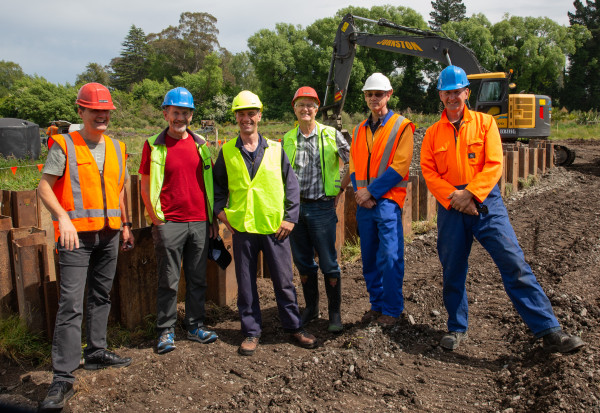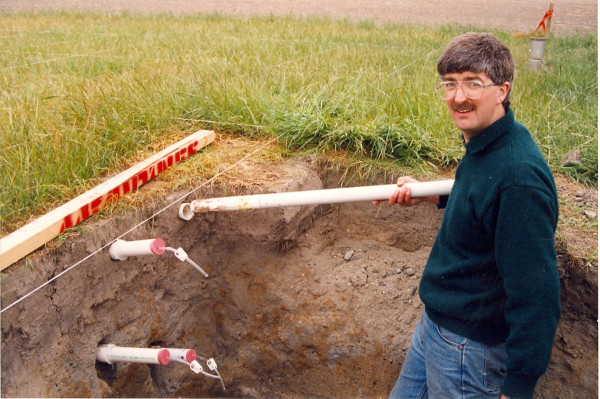How did you get into groundwater research?
“I'm a chemist by training, but when I finished my degree, I just applied for research positions with the word ‘scientist’ in the title. I was offered a groundwater quality scientist role, and another one looking at animal health. I chose groundwater.
I started out at the Water and Soil Division of the Ministry of Works and Development in 1979. After some reorganisations in the late 1980s, we were moved into Geophysics Division of DSIR (the Department of Scientific and Industrial Research – a former government science agency that was broken into Crown Research Institutes in 1992). The group consisted of some chemists like me, as well as microbiologists, hydrologists, modelers and geophysicists - a multidisciplinary group, which is what you need to study groundwater.
After DSIR was restructured in 1992, I had about four months at GNS before the Christchurch office was closed down and I was made redundant. I was offered a job at ESR to basically grow a groundwater research group. In the 30 years that I’ve been here, we’ve grown from three people to almost 20.”
Murray talking about the results of the pesticide leaching trial near Nelson to a group of farmers, council staff and other researchers during a site field visit.
What are some of the biggest changes you've seen in how groundwater is monitored and managed?
“There's been a lot of progress made, but there's a lot more to be done. In terms of the management of groundwater and the understanding of groundwater flow processes, the challenge comes from knowing exactly where or how deep the groundwater is. It’s also difficult to sample because the number of wells are limited - and expensive to install and sample – meaning we have a lot less information to work with compared to many other environments.
Groundwater scientists have to make inferences based on this limited information, so in terms of finding out what’s going on, you have to weigh the limited information against the uncertainty around that information. I think there's now a much greater understanding of this uncertainty associated with groundwater flow paths, but for a lot of people it's very much out of sight and out of mind. So it's a challenge to get the information, and it’s also a challenge to get funding for that information because it can be out of sight and out of mind for funders as well.”

Murray (third from right) at the construction site of ESR's denitrification wall at Silverstream Reserve in Canterbury.
What advances have there been in the technology you can use?
“The pathogen surrogates(external link) that Dr Liping Pang has developed is world-leading. These surrogates mimic the physiochemical properties of waterborne pathogens like rotavirus and Cryptosporidium protozoa to predict water contamination risks and help design improved water treatment systems and water-supply bore protections to keep our drinking water safe.
The geophysics monitoring we can now do using radar signals to generate reflections of the groundwater is giving us a lot of information about soil moisture, where the water table is, how deep the aquifer is, and how thick it is. We've also been trialling some high frequency monitoring of nitrates and water levels. These sorts of technologies give much greater insights of the processes that are happening in the groundwater.
There’s been a big increase in the number of analytical techniques we can use too, allowing us to detect things like pesticides and emerging organic contaminants and survey the presence of these in groundwater.
The techniques for looking at the biology and the microbiology of groundwater systems have also exploded in terms of DNA techniques. eDNA identification techniques(external link), for example, have enabled us to do a whole lot more studies into the natural groundwater ecosystem, which is fascinating.”
Have the threats to groundwater changed? Are there more environmental risks now than when you started?
“I think we're more aware of some of the threats. Farming is a big issue, particularly in terms of the nitrates that get into the groundwater(external link). One way of stopping this is to reduce the source of the nitrates getting into groundwater. But in some aquifers groundwater flow times are slow - 50 to 100 years easily (that’s in New Zealand - in some other parts of the world, it can take thousands of years). It means there’s a big lag time between nitrates entering the groundwater and making it into the surface water.
Around Pukekohe, for example, where a lot of vegetables are grown, the groundwater has some of the highest nitrate levels in New Zealand. Vegetables have been grown here for over 100 years, but the mean age of the groundwater is about 50 years. Even if we stopped nitrates entering the groundwater now, there would still be high levels coming out for the next 50 years. That’s why we also need mechanisms for removing the nitrate before it impacts the surface streams.
Nitrates from farming aren’t the only issue. Other pollutants include industrial chemicals, such as from degreasing agents, or industrial plasticizers, which can get into groundwater too.
Then there is the higher intensities and durations of rainfall that we’re seeing as a result of climate change. This increases microbial transport to the groundwater: the more saturated the conditions at the soil surface and in the unsaturated zone, the more microbial transport there is.”
Murray with fellow ESR groundwater scientist Allanah Kelly.
Why are groundwater scientists so essential?
“Groundwater systems contain about 97% of the usable freshwater in the world. Lakes and rivers represent a very small 3% of usable freshwater. Groundwater sustains the flow of all the rivers and streams through the summer period, making it a critical part of the water cycle, and yet it's not widely recognised. Groundwater scientists are essential to building good understanding and knowledge of groundwater - and through their work - make it more visible.
The importance of groundwater hasn't changed, if anything it has increased, so I think it's a really critical area to work in. There's lots of really interesting problems to address and a great bunch of people in the regional councils, at ESR, and other research institutes to work with.”
What achievement are you most proud of?
“A paper I did for the Journal of Water and Health in 2008. It was a three-year study looking at the issue of microbial transport into groundwater under flooded irrigated situations(external link). We looked at a dairying area that had a high percentage of flooding irrigation, so expected a worse case situation for microbial transport. We found that 75% of the samples collected during the irrigation season had E. coli in them, and at quite a high level. We also found about 12% of the samples had detectable Campylobacter in them. As people were using this water for drinking, we then decided to do a health risk assessment to find out what your chance of getting sick was. During the six-month irrigation season, we found that people drinking the water had about a 70% chance of getting sick with Campylobacter.
I then divided Canterbury up into three regions: dairying with flood irrigation; the rest of rural Canterbury (non-flood irrigation areas); and Christchurch city. There were significantly higher levels of gastroenteritis, campylobacteriosis and other gastro diseases in the flooded land-use situation, versus the other areas.
It was a really neat piece of work in terms of looking at what microbial contamination was there, what was the health risk was, and what the epidemiological outcomes of that were. The paper has been cited about 100 times, and even though people were already starting to move away from flood irrigation towards spray irrigation on the basis of water use efficiency, I think this study also helped.”
What does the Royal Society Fellowship mean to you?
“It was a bit of a surprise as I think I’d been in the nomination pool for about five years! I’m still sort of getting my head around what it means, but on a personal level it’s very pleasing. I think it reflects on some great people I've worked with over the years and the different projects I've been involved in. There's been recognition with the outstanding achievement award from the Hydrological Society, but it's good to get groundwater recognised in the wider research field.”

Murray holding a ceramic soil water extraction lysimeter at the pesticide leaching trial in Hawkes Bay in the mid 1990’s.
Find out more about ESR’s groundwater work(external link), read Murray’s profile(external link) or view the Fellows elected to the Academy of the Royal Society Te Apārangi(external link).
